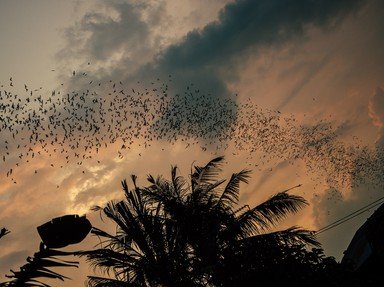Quiz Answer Key and Fun Facts
1. As night fell near Philadelphia in the USA, Gloria hurried to make camp before the promised storms. Suddenly, she saw a light, a little flash at hip height. "Hello?" she called to the empty campground. There was no answer except for more flashes -- in the grass, in the bushes, in the air. What creature had Gloria encountered?
2. It was toward the end of a stormy night when Seretse suddenly awoke in the Ghanzi District of Botswana. He'd heard loud animal calls, and when he peeked outside, he saw small, bushy-tailed creatures dashing up a tree. One of them made a vertical jump of almost two meters (6.6 feet)! What nocturnal mammals were just heading to bed?
3. Camping on New Zealand's South Island, Elisabetta ventured outside her tent to answer the call of nature. When her eyes adjusted to the moonlight, she spotted a large, grayish-brown bird in a burrow. Through the slight drizzle, it peered at her quizzically; she thought she saw nostrils at the end of its beak. When it shifted slightly, she caught a glimpse of an enormous egg beneath it. What bird did Elisabetta just meet?
4. At twilight, Emory was washing dishes at his campsite in West Virginia, in the USA. He stopped when he heard a loud rustling noise; he looked up, and saw a dark cloud rising from the caves across the river. Soon he realized that the cloud was made of creatures, which wheeled and spun in the air as they located their prey. What insectivores made such a dramatic entrance that evening?
5. When Jin awoke near Vancouver, Canada, the situation soon became clear. First, there were sounds of something rummaging through garbage. Next, there was shouting: "Get out of here!" Finally, the campsite was filled with an overwhelmingly unpleasant smell of burning rubber and rotting eggs. What animal had invaded the campground?
6. Staying in a dacha a few hours from Moscow, Russia, Heloise was glad to be behind closed doors when she was awakened after midnight by howls. She rushed to the window in time to see a pursuit across the snow: a moose being chased by silvery, four-legged creatures with their tails held high. Which of these predators did Heloise see that night?
7. As she and her friends returned to their cabin in the Peruvian jungle, Annemarie heard a rustling noise. From the corner of her eye, she saw a large, dark shape with a white face, climbing a high tree to escape from her group! It almost looked like a bear, but she didn't think that could be right. What nocturnal animal had Annemarie and her friends surprised?
8. Ahmed was just settling down on Hainan Island, in southern China, when he heard strange noises. Turning to peek outside the tent, he saw a nearby anthill being ripped apart by something in what appeared to be heavy, scaled armor. When far-off thunder startled the creature, it suddenly rolled itself into a ball. What scourge of anthills and termite mounds did Ahmed just see?
9. Two hours outside Minneapolis, in the U.S., Englebert couldn't sleep, so he watched the wildlife outside his tent. Occasionally he heard the call "Ho ho hoo, hoo hoo," loud and low. After his eyes had adjusted to the moonlight, he saw a tufted bird high in a nearby tree, swiveling its head around to get a good view in its large eyes. Suddenly, it swooped down, and came back up with a mouse in its talons. What carnivore just earned a meal?
10. In the Serengeti National Park, in Tanzania, Bob was startled awake by a clap of thunder. When he made his way to the window of his cabin, a flash of lightning illuminated a gruesome scene: a dead impala dangling from a tree. What nocturnal carnivore most likely made this kill?
Source: Author
CellarDoor
This quiz was reviewed by FunTrivia editor
crisw before going online.
Any errors found in FunTrivia content are routinely corrected through our feedback system.

